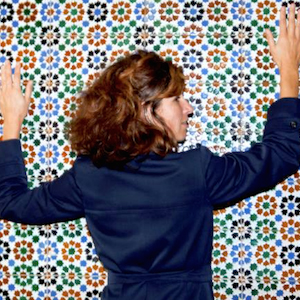"We sleep in them, we put them on our dining tables, we wear them as clothes, we dry ourselves with them after a shower and we use them to adorn the floors of our living rooms. Textiles are by definition close to us, so close that we are even a little unaware of their existence”, says Els Huygelen. Huygelen trained as a visual artist but works as a textile designer, designing anything from wallpaper to bed sheets and carpets. Now she is putting textiles under the spotlight at the Design Museum Gent in the Plain/Purl: Textiles Between Art and Design exhibition.
Bringing together work by both international artists and alumni from several textile schools in Gent, Huygelen says:

The exhibition introduces us to art, designs, and drawings by the likes of Petra Blaisse, Louise Bourgeois, Ronan & Erwan Bouroullec, Chevalier-Masson, Berlinde De Bruyckere, Sonia Delaunay, Martine Geyselbrecht, Hella Jongerius, Christoph Hefti, Muller Van Severen, Bertjan Pot, Pascale Marthine Tayou, Rosemarie Trockel and Franz West, as well as former textile design students. Valerie Mannaerts, Kristof Van Gestel, Joel Gomez and Henri Jacobs have also created new work for the exhibition. The ratio of designers to visual artists is about 50:50.
 Eye-catchers include a vivid black-and-white drawing of a blanket with floral designs by Belgian painter Rinus Van De Velde, a screen and three little pouffes by Dutch designer Hella Jongerius, Carole Vanderlinden’s small textile-inspired paintings, and large-scale knitted and crocheted installations by Klaas Rommelaere. Huygelen's approach differs from the traditional way of dealing with fine art and design in museums:
Eye-catchers include a vivid black-and-white drawing of a blanket with floral designs by Belgian painter Rinus Van De Velde, a screen and three little pouffes by Dutch designer Hella Jongerius, Carole Vanderlinden’s small textile-inspired paintings, and large-scale knitted and crocheted installations by Klaas Rommelaere. Huygelen's approach differs from the traditional way of dealing with fine art and design in museums:

 This makes sense in Gent, not only historically a textile industry city, but now the only one in Belgium with two high-quality textile design courses that unite many of the textile professionals in the country. Moreover, there is nowhere a ‘plz don’t touch the pieces’ announcement to be seen.
This makes sense in Gent, not only historically a textile industry city, but now the only one in Belgium with two high-quality textile design courses that unite many of the textile professionals in the country. Moreover, there is nowhere a ‘plz don’t touch the pieces’ announcement to be seen.
The title makes smart reference to this too. ‘Averechts’ (purl) is a knitting stitch, but in Flemish it also refers to a personality trait that is said to be native to the inhabitants of the Belgian city of Gent, which since the Middle Ages had to witness a never-ending passage of foreign rulers. Sometimes the citizens managed to kick them out, but more often they had to bow their heads. As a result they became ‘averechts’: contrary with a rebellious playfulness.
Bringing together work by both international artists and alumni from several textile schools in Gent, Huygelen says:

Chevalier Masson
"These alumni are trained to work with textiles for industry, whereas for many visual artists, textiles are often actually a great source of inspiration. Or even much more: look at how for example James Ensor used textiles as a protagonist: he sometimes combines wallpaper with a flower motif, women in dresses with striking motifs, a tablecloth with yet another motif - all in one painting. This painter clearly enjoyed playing with colours and motifs, just like fashion designers do."
The exhibition introduces us to art, designs, and drawings by the likes of Petra Blaisse, Louise Bourgeois, Ronan & Erwan Bouroullec, Chevalier-Masson, Berlinde De Bruyckere, Sonia Delaunay, Martine Geyselbrecht, Hella Jongerius, Christoph Hefti, Muller Van Severen, Bertjan Pot, Pascale Marthine Tayou, Rosemarie Trockel and Franz West, as well as former textile design students. Valerie Mannaerts, Kristof Van Gestel, Joel Gomez and Henri Jacobs have also created new work for the exhibition. The ratio of designers to visual artists is about 50:50.

Wall hanging by Bertjan pot and poufs by Hella Jongerius.
"I want to show that textile design doesn’t need to be predictable - you can go wild, even punk. It’s not necessarily just for grannies. Our exhibition avoids the established usual suspects too - we are doing something completely different with textiles. We want to tease you into rediscovering and cherishing the craftsmanship associated with textiles.”

work by various alumni

Klaas Rommelaere
"In this exhibition you are allowed to touch and feel everything that is on display, design and fine art pieces alike - besides some fragile works, such as one by Louise Bourgeois. The security staff were sceptical at first but are now impressed by how well kept everything still is. Doing it this way I want to make visual arts as accessible as textiles. Close to us, on our skin.”
The title makes smart reference to this too. ‘Averechts’ (purl) is a knitting stitch, but in Flemish it also refers to a personality trait that is said to be native to the inhabitants of the Belgian city of Gent, which since the Middle Ages had to witness a never-ending passage of foreign rulers. Sometimes the citizens managed to kick them out, but more often they had to bow their heads. As a result they became ‘averechts’: contrary with a rebellious playfulness.

 Henri Jacobs
Henri Jacobs
 Pascale Marthine Tayou
Pascale Marthine Tayou
 Rinus Van De Velde
Rinus Van De Velde


